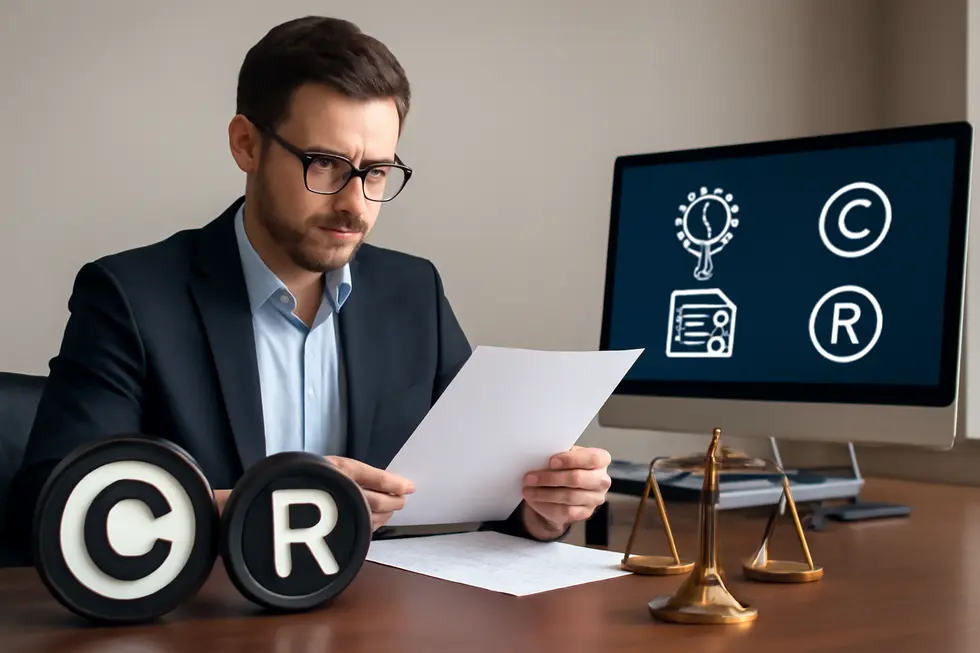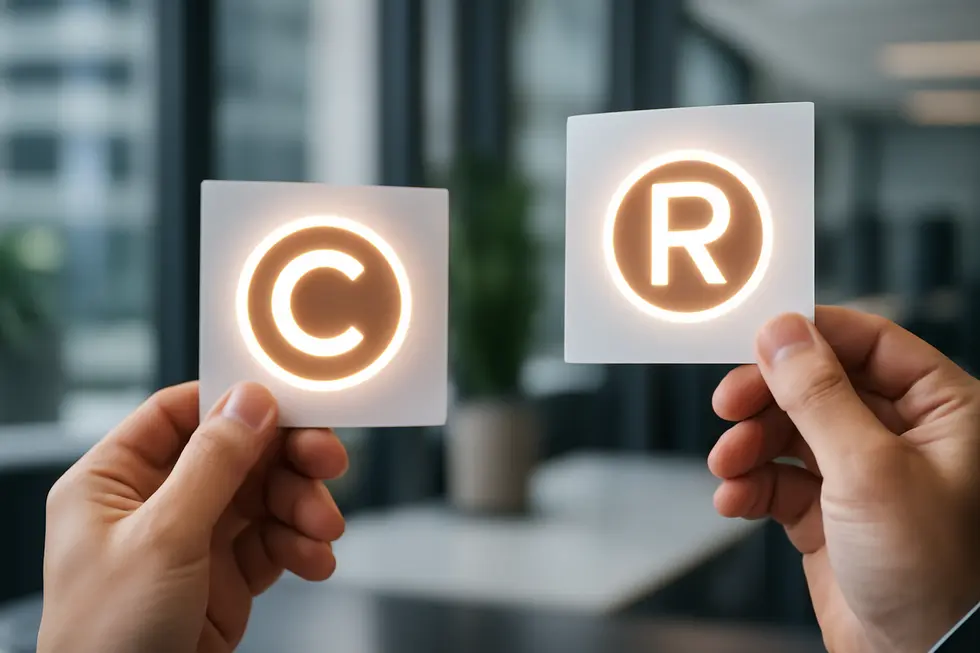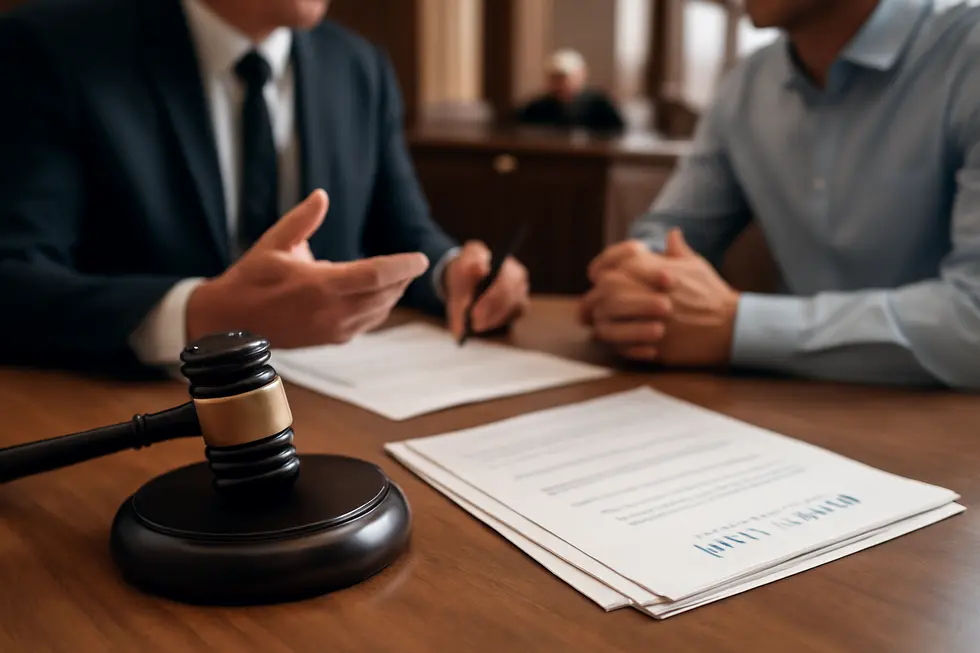Introduction
For business owners, recognizing the distinct protections offered by copyright and registered trademarks is vital to safeguarding your company’s creative and brand assets. Copyright protects original works such as books, music, and software, while registered trademarks defend brand identifiers like names and logos that set your business apart in the market. This knowledge empowers you to make informed decisions about intellectual property rights, registration processes, enforcement, and strategic management. Each chapter unfolds critical aspects of copyright and registered trademark protections, from legal definitions to registration procedures, symbols, duration, enforcement, and practical considerations. By understanding these differences and their unique roles in your business, you will be better equipped to secure and leverage your competitive advantage.
Tables of Contents
Chapter 1: Understanding Copyright and Registered Trademark: Definitions and Legal Basis
- Legal Foundations That Distinguish Copyright and Registered Trademark Protection
- Distinguishing Copyright from Registered Trademark: Core Protections and Legal Foundations
- Rights and Enforcement: How Copyright and Registered Trademarks Secure Creative and Brand Assets
- Establishment, Duration, and Symbol Usage in Copyright and Registered Trademarks
- Economic and Societal Impact: The Crucial Roles of Copyright and Registered Trademark Protections
Chapter 2: Key Differences Between Copyright and Registered Trademark Protection
- Distinctive Purposes and Roles: How Copyright and Registered Trademarks Safeguard Creativity Versus Commercial Identity
- Distinct Boundaries: Exploring the Scope and Subject Matter of Copyright vs. Registered Trademarks
- Navigating the Legal Lifespans: How Duration Defines Copyright and Trademark Protections
- Navigating Registration and Legal Formalities: How Copyright and Trademark Protections Diverge
- Distinct Enforcement Strategies and Symbolism in Copyright vs. Registered Trademark Rights
Chapter 3: The Trademark Registration Process and Importance of Copyright Registered Trademark Distinction
- Navigating the Trademark Registration Journey: Securing Your Brand’s Legal Identity
- Clarifying Intellectual Property Boundaries: How Copyright and Registered Trademark Protect Different Assets
- Navigating Trademark Registration: Key Steps and Legal Benefits of Federal Registration
- Economic Benefits of Trademark Registration and Clear Intellectual Property Differentiation
- Navigating Technological Advances and Societal Roles in Trademark Registration and Intellectual Property Protection
Chapter 4: Symbols and Legal Significance in Copyright and Registered Trademark
- Decoding the Legal Language: How Copyright and Trademark Symbols Communicate Protection
- Decoding ©, ™, and ®: Essential Symbols Defining Copyrights and Trademarks
- How © and ® Symbols Shape Legal Authority and Market Value
- The Transformative Role of © and ® Symbols in Modern IP Enforcement and Societal Trust
- Navigating Geopolitical Impact on International Protection of Copyright and Trademark Symbols
Chapter 5: Duration, Enforcement, and Legal Remedies in Copyright and Registered Trademark Protection
- Navigating Legal Timeframes and Durations in Copyright and Registered Trademark Enforcement
- Integrated Enforcement Strategies and Legal Remedies for Copyrights and Registered Trademarks
- Navigating Legal Remedies and Judicial Relief in Copyright and Trademark Enforcement
- Extending Legal Reach: The Critical Role of Contributory Liability in Copyright and Trademark Enforcement
- Navigating Duration, Enforcement, and Remedies: Practical Insights on Copyrights and Registered Trademarks
Chapter 6: Practical Implications and Strategic Considerations for Copyright Registered Trademark Management
- Maximizing Protection: Strategic Legal Registration and Enforcement of Copyrights and Trademarks
- Proactive Monitoring Strategies for Sustained Copyright and Trademark Protection
- Creating Robust Usage Guidelines to Safeguard Copyright and Trademark Assets
- Integrated Enforcement Strategies and Litigation Tactics for Sustained IP Protection
- Contractual Strategies and Risk Management in Intellectual Property Rights Administration
Chapter 1: Understanding Copyright and Registered Trademark: Definitions and Legal Basis

1. Legal Foundations That Distinguish Copyright and Registered Trademark Protection
Copyright grants creators exclusive rights over original works fixed in a tangible form, protecting the expression rather than the idea itself. Its legal basis stems from statutes like the Copyright, Designs and Patents Act 1988 (CDPA) in the UK, offering automatic protection upon creation. Copyright covers economic rights to reproduce and distribute and moral rights to attribution and integrity. In contrast, registered trademarks protect distinctive signs like logos, names, or slogans that identify goods or services. Trademark protection depends on formal registration with governmental bodies and grants exclusive commercial use within registered territories. Unlike copyright’s limited duration, trademarks endure indefinitely through renewal and continuous use. Both systems are territorial but supported internationally by treaties such as the Berne Convention for copyright and national registration frameworks for trademarks. This distinction defines their scope and enforcement, reflecting their complementary roles in intellectual property law. For more details, see the trademark registration process. More about copyright law can be found at the Berne Convention.
2. Distinguishing Copyright from Registered Trademark: Core Protections and Legal Foundations
Copyright safeguards original creative works such as books, music, films, and artwork by granting creators exclusive rights to reproduce, distribute, and display their specific expressions. It protects expression, not ideas or facts, and arises automatically upon fixation in a tangible medium, with registration offering enhanced legal remedies. In contrast, a registered trademark protects distinctive brand identifiers—like names, logos, and slogans—that differentiate goods or services in commerce. Trademark rights develop through use or registration with the USPTO, providing nationwide exclusivity and stronger enforcement. While copyright lasts the author’s life plus 70 years, trademarks can endure indefinitely if actively maintained. Fundamentally, copyright secures creative content, whereas trademarks shield brand identity and consumer recognition. For further details, see trademark protection for business names and logos. External information referenced from USPTO resources.
3. Rights and Enforcement: How Copyright and Registered Trademarks Secure Creative and Brand Assets
Copyright grants creators exclusive control over the reproduction, distribution, public display, and adaptation of original works. It protects creative expressions fixed in tangible form by establishing both economic rights, which provide monetary benefits, and moral rights, safeguarding the creator’s reputation. Enforced primarily through legal injunctions and damages, copyright serves as a negative right, preventing unauthorized use rather than permitting it. In contrast, registered trademarks protect brand identity—names, logos, slogans—through exclusive commercial use authorized via federal registration. This positive right allows owners to prevent confusing or damaging infringements that harm consumer trust. Trademark enforcement includes federal court actions and customs protection, ensuring the integrity of the brand. Together, these mechanisms underpin distinct but complementary protections for intellectual property. For detailed legal frameworks, see Trademark2Go’s guide to trademark protection for business names and logos and consult the Berne Convention for the Protection of Literary and Artistic Works.
4. Establishment, Duration, and Symbol Usage in Copyright and Registered Trademarks
Copyright protection arises automatically upon creating an original work fixed in a tangible medium, granting exclusive rights like reproduction and distribution. It lasts the life of the author plus approximately 70 years. The © symbol signifies copyright but is not mandatory for protection. Conversely, a registered trademark requires formal registration through the USPTO to secure exclusive commercial use of brand identifiers such as names, logos, or slogans. Its protection initially spans ten years and can be renewed indefinitely with continued use. The ® symbol denotes federal registration, while ™ indicates unregistered marks. These differences highlight how creative expression and brand identity receive distinct legal recognition under separate frameworks. More details on trademark processes can be found at Trademark Protection for Business Name and Logo. For authoritative reference, see the U.S. Copyright Office.
5. Economic and Societal Impact: The Crucial Roles of Copyright and Registered Trademark Protections
Economic and societal implications of copyright and trademark protections extend far beyond legal rights. Copyright motivates creators by granting exclusive control over their original works, enabling economic benefits through licensing and sales while fostering cultural enrichment and innovation. It balances creators’ rights with public interests by safeguarding the expression of ideas without restricting access unduly. Registered trademarks bolster business by protecting brand identity, preventing consumer confusion, and encouraging fair competition. They build consumer trust, securing investments in quality and marketing, and help maintain market integrity. Together, these protections underpin creative and commercial ecosystems essential for economic growth and societal development. For a deeper exploration on copyright’s economic role, visit copyright definition economics for business.
Chapter 2: Key Differences Between Copyright and Registered Trademark Protection

1. Distinctive Purposes and Roles: How Copyright and Registered Trademarks Safeguard Creativity Versus Commercial Identity
Copyright protects original creative expressions, such as books, music, art, and software, focusing on the fixed form of an idea. Its purpose is to prevent unauthorized copying or distribution of these works. In contrast, a registered trademark safeguards brand identifiers like names, logos, and slogans that distinguish goods or services in the marketplace. Trademark protection aims to prevent consumer confusion by ensuring exclusive commercial use of distinctive marks. While copyright protection arises automatically upon creation, trademark rights require formal registration with the USPTO for federal benefits. Moreover, copyright typically lasts for the creator’s life plus 70 years, whereas trademarks can endure indefinitely if maintained through continuous use and renewal. This fundamental distinction highlights how copyrights secure creative content, while registered trademarks protect the commercial identity crucial for brand recognition. For further details, see trademark protection for business name and logo.
2. Distinct Boundaries: Exploring the Scope and Subject Matter of Copyright vs. Registered Trademarks
Copyright and registered trademark protections serve distinct purposes centered on different types of intellectual property. Copyright safeguards the original expression of ideas fixed in tangible forms, such as literary, artistic, musical, or software works, without extending protection to the underlying ideas or facts themselves. In contrast, registered trademarks protect brand identifiers—names, logos, slogans, and symbols—used in commerce to distinguish the source of goods or services. This focus aims to prevent consumer confusion and preserve brand reputation. Copyright arises automatically upon creation, covering creative content for the author’s life plus 70 years, while trademark rights depend on use in commerce and federal registration, lasting indefinitely with renewal. Recognizing these boundaries is essential for choosing the proper intellectual property protection strategy. For further insights on trademark protection for business names and logos, see trademark protection for business names and logos.
Source: ebizfiling.com
3. Navigating the Legal Lifespans: How Duration Defines Copyright and Trademark Protections
Copyright protection spans the life of the author plus 70 years, or up to 95 years for corporate works, reflecting its fixed term tied to creativity. Protection arises automatically upon creation and ceases upon expiration. In contrast, registered trademark protection depends on active commercial use and registration. Initial terms last 10 years with indefinite renewals, maintaining rights as long as the mark is used and renewed. Failure to use or renew risks abandonment, ending protection. This distinct legal lifespan underscores their differing purposes: copyright encourages the creation of original works for a set period, while trademarks secure brand identity indefinitely in commerce. For detailed insights, see trademark protection for business names and logos. More on duration at UpCounsel.
4. Navigating Registration and Legal Formalities: How Copyright and Trademark Protections Diverge
Copyright protection is automatically granted once an original work is fixed in a tangible form. Registration with the U.S. Copyright Office, while optional, provides significant advantages such as eligibility for statutory damages, attorney’s fees, and the right to file infringement lawsuits. The process involves submitting an application, a copy of the work, and a fee that varies with the work type and method of submission. In contrast, trademark protection hinges on formal registration with the USPTO, requiring a detailed application proving usage in commerce and distinctiveness. This process includes examination, potential office actions, and renewals, securing indefinite rights if maintained properly. These fundamental differences highlight the ease of obtaining copyright protection versus the greater procedural complexity of trademarks. For further details, visit the USPTO website.
5. Distinct Enforcement Strategies and Symbolism in Copyright vs. Registered Trademark Rights
Copyright and registered trademark protections employ fundamentally different enforcement strategies aligned with their distinct purposes. Copyright enforcement targets unauthorized copying, distribution, or adaptation of creative works, securing original expression but not ideas or facts. Conversely, registered trademarks defend brand identity in commerce by preventing confusingly similar uses through strong federal protections granted upon USPTO registration. This includes expanded remedies under the Lanham Act and customs enforcement to block counterfeit goods. Symbols play a vital role in public notice: © marks copyrighted works, while ® signals federally registered trademarks with enhanced legal weight; unregistered trademarks use ™ to assert rights with limited enforcement. Registration rigorously supports trademark enforcement, while copyright protection arises automatically upon creation. For deeper insights into trademark protections, refer to Trademark Protection for Business Names and Logos.
External reference: https://www.jdsupra.com/legalnews/trademark-rights-explained-common-law-3256401/
Chapter 3: The Trademark Registration Process and Importance of Copyright Registered Trademark Distinction

1. Navigating the Trademark Registration Journey: Securing Your Brand’s Legal Identity
Navigating the Trademark Registration Journey begins with a meticulous search to ensure your chosen mark—be it a name, logo, or slogan—is unique and avoids infringement risks. Filing an application with the USPTO follows, where detailed descriptions of the trademark and its commercial use are submitted. This initiates a rigorous examination to confirm compliance with legal standards and assess conflicts. Once cleared, the mark is published for opposition, allowing others to contest its registration. Absent opposition, the trademark gains registration, bestowing exclusive legal rights to the owner. This federal registration not only deters unauthorized use but also solidifies brand identity, building customer trust and market authority. Essential to this process are avoiding generic marks, precise classification of goods or services, and maintaining renewal vigilance. For detailed guidance, consult the comprehensive resources available through the USPTO. This systematic procedure transforms a brand concept into protected intellectual property, a cornerstone in maintaining commercial distinctiveness and legal defense. For additional insights, see our detailed overview of trademark protection for business names and logos.
2. Clarifying Intellectual Property Boundaries: How Copyright and Registered Trademark Protect Different Assets
Distinguishing copyright from registered trademark is essential because each protects unique intellectual property assets. Copyright safeguards original creative works, such as books, music, or software, focusing on an expression fixed in tangible form. It arises automatically upon creation but registering it enhances legal enforcement. Conversely, registered trademarks protect brand identifiers like names, logos, and slogans, granting exclusive commercial rights nationwide once registered with the USPTO. While copyright duration spans the author’s life plus 70 years, trademarks can last indefinitely through renewal and continuous use. Understanding these differences helps avoid legal conflicts and ensures proper protection for both creative content and brand identity. For in-depth details on these distinctions, see this comprehensive resource on trademark vs copyright vs patent and explore trademark protections at trademark protection business name logo.
3. Navigating Trademark Registration: Key Steps and Legal Benefits of Federal Registration
The trademark registration process begins with a comprehensive search to ensure the mark is unique and not already in use. Filing an accurate application with the USPTO follows, including ownership details and specimens demonstrating use. After submission, an examiner reviews the application for compliance and potential conflicts, during which objections may arise. Successful applications are published to allow third-party opposition. Without opposition or once resolved, the mark gains registration status, granting nationwide exclusive rights. Maintaining a trademark requires periodic renewals and infringement monitoring to preserve protection. Registered marks benefit from legal presumptions of ownership, public notice that deters infringement, and the right to use the ® symbol. These protections extend to customs enforcement and federal court remedies, offering stronger rights than unregistered marks. For a deeper understanding of protecting a business’s name and logo, visit trademark protection business name & logo.
4. Economic Benefits of Trademark Registration and Clear Intellectual Property Differentiation
Trademark registration plays a pivotal role in strengthening businesses economically by granting exclusive rights to brand identifiers. This exclusivity deters infringement while enhancing brand credibility and customer trust, essential for growth and franchising opportunities. Registered trademarks become valuable intangible assets that can generate revenue through licensing or sales. In contrast, copyright protections safeguard original creative works but do not cover brand identity. Understanding this distinction ensures businesses implement the right protections to secure their assets effectively. While copyright arises automatically, trademark rights require formal registration for full nationwide enforcement and long-term commercial benefits. Recognizing these differences supports strategic brand development and economic success. For deeper insights into trademark protection for business names and logos and its economic implications, official USPTO resources offer comprehensive guidance.
5. Navigating Technological Advances and Societal Roles in Trademark Registration and Intellectual Property Protection
The trademark registration process merges advanced technology with societal needs to protect brand identity and foster market trust. Digital identity verification, like USPTO’s adoption of secure platforms, guards against fraud and unauthorized filings, ensuring integrity in an evolving digital commerce environment. Beyond technology, trademarks have deep societal significance—they prevent consumer confusion, protect business reputation, and preserve competitive fairness by securing exclusive brand identifiers. Moreover, as commerce embraces digital innovation, trademark law adapts to cover virtual assets such as NFTs and blockchain-based goods. Understanding this, alongside the distinct roles of copyright and registered trademarks, empowers creators and businesses to safeguard intellectual property effectively. For detailed procedural insight, explore the trademark protection for business name and logo and USPTO resources on registration.
Chapter 4: Symbols and Legal Significance in Copyright and Registered Trademark

1. Decoding the Legal Language: How Copyright and Trademark Symbols Communicate Protection
Symbols such as ©, ®, ™, and ℠ are vital legal signals, conveying ownership and protection status in intellectual property law. The © symbol marks original creative works, alerting the public to copyright protections, though its use is optional since rights exist upon creation. In contrast, trademark symbols distinctly identify brand rights: ™ and ℠ claim unregistered trademarks or service marks, while ® denotes federally registered trademarks with exclusive nationwide legal protections. The ® symbol empowers owners to enforce rights through federal courts and customs actions against infringement. These symbols not only clarify ownership but also prevent consumer confusion and deter unlawful use, reinforcing the commercial and creative value each protects. For further insight into trademark legal foundations, see trademark protection for business names and logos. An authoritative overview of copyright symbol use is available at Symbols.com.
2. Decoding ©, ™, and ®: Essential Symbols Defining Copyrights and Trademarks
The symbols ©, ™, and ® serve as vital indicators distinguishing types of intellectual property protection, each with unique legal meanings and usage contexts. The © symbol denotes copyright protection for original creative works like books, music, and art, automatically granted upon creation without mandatory registration. In contrast, the ™ symbol signals an unregistered trademark claim, marking a brand identifier such as a name or logo but without formal legal registration or nationwide protection. The ® symbol, however, signals a registered trademark officially recognized by the U.S. Patent and Trademark Office, granting exclusive legal rights and stronger enforcement against infringement. Misuse of ® without registration can lead to penalties. Copyright covers the expression of ideas fixed in tangible form, while trademarks protect brand identifiers that distinguish goods or services in commerce. Proper understanding of these symbols helps businesses and creators assert and safeguard their intellectual property rights effectively. For an in-depth legal perspective on trademarks, see more at trademark protection for business name and logo. Additional authoritative information on copyright symbols can be found at Symbols.com.
3. How © and ® Symbols Shape Legal Authority and Market Value
© and ® symbols do more than indicate ownership—they confer distinct legal and economic power. The registered trademark symbol ® signals federal registration, providing nationwide protection that deters infringement and supports enforcement under laws like the Anticybersquatting Consumer Protection Act. This legal backing empowers trademark owners to block unauthorized use, safeguarding brand identity. Economically, the ® symbol boosts consumer trust and brand goodwill, aiding licensing and preventing dilution. In contrast, the copyright symbol © marks protection over original creative works, enabling control over copying and distribution but not protecting brand identifiers like names or slogans. Together, these symbols clarify rights, enhance enforcement, and create commercial value vital for intellectual property success. For a deeper legal perspective, see the trademark protection for business names and logos.
4. The Transformative Role of © and ® Symbols in Modern IP Enforcement and Societal Trust
Copyright © and registered trademark ® symbols transcend mere legal formality; they are critical markers that enable advanced technological enforcement and shape societal perception. In digital realms, AI-driven tools scan content across platforms to detect trademark misuse swiftly, aiding rapid enforcement. Virtual environments, from gaming to metaverse spaces, increasingly rely on these symbols to uphold brand integrity despite decentralized challenges. Meanwhile, NFTs add complexity, demanding strategic trademark management to protect digital assets. Societally, these symbols bolster consumer confidence by distinguishing authentic products and content, while encouraging creators and brands to respect intellectual property boundaries. Collaboration among creators, platforms, and rights holders enhances education and enforcement effectiveness. Such dynamic interplay underscores the evolving power of these symbols in protecting IP rights amid expanding digital commerce and creativity. For deeper understanding, explore trademark protection strategies at Trademark Protection Business Name Logo.
5. Navigating Geopolitical Impact on International Protection of Copyright and Trademark Symbols
Geopolitical influences profoundly shape how copyright and registered trademark symbols are recognized and enforced globally. Copyright protections vary by country, influenced by distinct legal traditions and cultural values enacted through international treaties like the Berne Convention and TRIPS. Meanwhile, trademark rights are territorially limited, with federally registered marks protected nationally and international safeguards relying on treaties such as the Madrid Protocol. Cross-border enforcement faces challenges from inconsistent laws and geopolitical tensions, which sometimes prioritize national interests over international IP commitments. This complex landscape requires rights holders to understand geopolitical factors that affect territorial licensing, enforcement options, and symbol recognition, underscoring the convergence of intellectual property with global economic and political dynamics. For in-depth guidance on trademark nuances, see common law trademark rights. Further insights on these issues can be found through resources like the Council on Foreign Relations analysis of WTO and TRIPS frameworks.
Chapter 5: Duration, Enforcement, and Legal Remedies in Copyright and Registered Trademark Protection

1. Navigating Legal Timeframes and Durations in Copyright and Registered Trademark Enforcement
Copyright protection extends for the life of the author plus 70 years for individual works, while corporate works last 95 years from publication or 120 years from creation, whichever is shorter. Protection arises upon fixation, but registration with the U.S. Copyright Office enhances enforcement options. In contrast, registered trademarks can endure indefinitely, provided they are actively used in commerce and renewals are timely filed—initially after 5 years, then every 10 years. Missing renewal deadlines or failing to respond to USPTO office actions within six months risks abandonment or loss of rights. These strict timeframes ensure trademarks maintain their exclusive status and legal strength against infringement claims. Understanding and complying with these durations and procedural periods are vital to preserving intellectual property rights effectively. More details on trademark essentials are available at Trademark Protection for Business Name & Logo.
For authoritative guidance on duration and registration specifics, the USPTO provides comprehensive resources. Adhering to these legal timelines safeguards the enforceability and longevity of copyrights and registered trademarks from a legal remedies standpoint.
2. Integrated Enforcement Strategies and Legal Remedies for Copyrights and Registered Trademarks
Integrated Enforcement Strategies and Legal Remedies for Copyrights and Registered Trademarks
Effective protection of copyrights and registered trademarks relies on timely enforcement supported by legal and administrative strategies. Copyright enforcement often combines AI-driven detection with manual review to identify unauthorized reproductions or displays, backed by formal DMCA takedown requests and litigation if necessary. Maintaining detailed creation records, digital signatures, and watermarks strengthens claims. For trademarks, active monitoring of brand use enables swift legal complaints and infringement suits, while updating contracts and educating partners prevents future misuse. Contractual clauses like indemnifications and IP insurance help mitigate litigation risks. Emerging trends reveal platform-based automated enforcement and AI tools enhancing efficiency. Together, these mechanisms ensure sustained protection of intellectual property rights throughout their duration, complementing statutory frameworks. For deeper insights on trademark safeguards for business identity, visit trademark protection for business and consult authoritative legal guides.
3. Navigating Legal Remedies and Judicial Relief in Copyright and Trademark Enforcement
Legal remedies for copyright and registered trademarks differ significantly due to their unique protections and durations. Copyright lasts for the life of the author plus 70 years, while trademarks can endure indefinitely with timely renewals and ongoing use. Enforcement begins with identifying infringement—copyright owners may use cease and desist letters and the DMCA takedown process before pursuing civil suits that seek statutory or actual damages and injunctions. Trademark enforcement often involves administrative proceedings at the USPTO’s Trademark Trial and Appeal Board for registration matters. Actual infringement disputes proceed to federal or state courts, where remedies include injunctions, damages, profits recovery, and enhanced awards for willful violations. These tailored legal frameworks emphasize preventing unauthorized copying with copyright and consumer confusion with trademarks, offering complementary protections under separate statutes. For deeper insights on trademark enforcement, see the USPTO Trademark Trial and Appeal Board overview.
4. Extending Legal Reach: The Critical Role of Contributory Liability in Copyright and Trademark Enforcement
Contributory liability expands enforcement beyond direct infringers to those who knowingly enable or materially contribute to unauthorized use. In copyright law, liability arises when a party with actual or constructive knowledge facilitates infringement by providing tools or inducements. Trademark law similarly holds facilitators accountable when they aid misuse with awareness or willful blindness, preventing indirect actors from escaping responsibility. Landmark cases such as Inwood Laboratories v. Ives Laboratories and Tiffany & Co. v. eBay Inc. clarify these doctrines, balancing protection and fair use. This doctrine enhances enforcement by allowing rights holders to seek injunctions and damages against secondary parties, ensuring comprehensive protection throughout the rights’ duration. For detailed procedural insights on protecting trademarks, consult this trademark protection guide. Additional analysis on contributory liability can be found in recent Supreme Court considerations like Cox Communications v. Sony Music Entertainment.
5. Navigating Duration, Enforcement, and Remedies: Practical Insights on Copyrights and Registered Trademarks
Duration and Legal Enforcement differ fundamentally between copyright and registered trademarks. Copyright protects creative works for the life of the author plus 70 years, or up to 95 years for corporate authorship, providing long-lasting exclusive rights based on creation. Conversely, registered trademarks can last indefinitely, contingent on continuous commercial use and timely renewals, emphasizing ongoing brand identity protection. Enforcement for copyright targets unauthorized copying, offering remedies like injunctions and damages, often strengthened by registration. Trademark enforcement focuses on preventing consumer confusion, utilizing cease-and-desist actions, litigation, and sometimes administrative or criminal measures, particularly against counterfeiting. These distinctions shape strategic IP protection—businesses must maintain active trademark use, while copyrights depend on original creation and statutory limits. For a deeper legal perspective on these protections, see the comprehensive Dilworth IP guide on trademark and copyright differences.
Chapter 6: Practical Implications and Strategic Considerations for Copyright Registered Trademark Management

1. Maximizing Protection: Strategic Legal Registration and Enforcement of Copyrights and Trademarks
Maximizing Protection through Legal Registration and Enforcement is essential for effective intellectual property management. While copyright protection begins upon creation, registering with the U.S. Copyright Office formalizes ownership, enabling statutory damages and legal enforcement. Conversely, trademark registration with the USPTO is mandatory for federal protection, establishing exclusive rights and requiring ongoing maintenance. Enforcement for both involves vigilant monitoring and prompt action against infringement, including cease-and-desist notices and formal litigation if necessary. Strategically, maintaining clear ownership and proactive infringement detection preserves the value and distinctiveness of both creative works and brand identities. Failing to enforce rights risks weakening future claims and eroding competitive advantage. For deeper legal insights, consult common-law trademark rights guidance and explore enforcement procedures detailed through authoritative legal resources.
2. Proactive Monitoring Strategies for Sustained Copyright and Trademark Protection
Proactive surveillance is essential in managing both copyrights and registered trademarks to safeguard intellectual property effectively. For trademarks, ongoing monitoring employs specialized watch services and AI-driven tools that scan databases, marketplaces, and social media for unauthorized use or similar applications. This real-time detection helps prevent costly disputes and brand dilution by enabling swift enforcement, including automated cease-and-desist actions. Copyright owners, especially in the age of AI-generated content, must continuously review outputs and distribution to detect infringements early, thereby minimizing legal risks. Integrating these monitoring practices within a comprehensive IP management plan, emphasizing international coverage and preemptive enforcement, ensures protection remains robust. Such strategies preserve the value of creative works and brand identity while reducing downstream legal expenses. For deeper insights, explore trademark protection for business names and logos.
3. Creating Robust Usage Guidelines to Safeguard Copyright and Trademark Assets
Developing robust usage guidelines is critical for protecting both copyrights and registered trademarks while preserving brand consistency. These guidelines clearly define how logos, taglines, and creative content should appear and be used internally and by external partners. Maintaining strict quality control ensures that trademark use meets brand standards, preventing dilution and reinforcing legal protections. Ongoing monitoring helps identify unauthorized usage across online platforms, enabling timely enforcement actions. Additionally, legal registration and strategic portfolio management underpin effective defense and growth of intellectual property assets. By aligning these practices with business goals, companies can enhance their market presence and mitigate risks related to misuse or infringement. For further insights on trademark protection, explore more at trademark protection for business names and logos.
4. Integrated Enforcement Strategies and Litigation Tactics for Sustained IP Protection
Effective management of copyrights and registered trademarks demands a strategic blend of proactive enforcement and well-planned litigation tactics. Initiating comprehensive registration and maintaining detailed documentation strengthen ownership claims and expedite infringement responses. Continuous monitoring across digital platforms uncovers unauthorized use early, allowing swift cease-and-desist actions or takedown requests. Building cooperative relationships with online enforcement teams enhances resolution speed and impact. When infringements persist, carefully selecting jurisdictions and employing tailored litigation tactics maximize legal protection and brand value retention. Cross-border coordination ensures enforcement aligns with diverse legal frameworks, safeguarding intellectual property worldwide. These integrated strategies collectively fortify rights holders’ ability to deter violations while supporting long-term commercial success. For deeper insights into safeguarding business identity, see trademark protection business name & logo.
5. Contractual Strategies and Risk Management in Intellectual Property Rights Administration
Contractual Strategies and Risk Management in Intellectual Property Rights Administration
Effective management of copyright and registered trademark rights hinges on meticulously crafted contracts that align with broader business strategies. Licensing agreements must clearly delineate usage scope, exclusivity, sublicensing permissions, and remedies for breaches while anticipating conflicts like bankruptcy or disputes. Risk allocation through indemnification clauses and liability limits safeguards parties from infringement claims and litigation costs. Employing intellectual property insurance further mitigates financial exposure. Freelancer and contractor agreements should specify IP ownership of pre-existing and newly created works alongside confidentiality provisions. Globally, contracts must address jurisdiction and incorporate dispute resolution mechanisms to protect brand identity and creative content effectively across borders. This integrated approach fortifies enforcement and sustains competitive advantage.
For more detailed insights, explore strategic IP portfolio management at PatentPC.
Final thoughts
Recognizing the distinct roles of copyright and registered trademarks is essential for business owners to effectively protect their creative works and brand identity. Copyright safeguards the expression of original ideas, granting exclusive rights that last for the author’s life plus decades, while registered trademarks secure the commercial use of brand elements indefinitely with proper maintenance. Understanding their differences, registration requirements, legal symbols, duration, enforcement mechanisms, and practical strategies enables businesses to build stronger, more defensible intellectual property portfolios. By proactively managing both copyrights and trademarks, entrepreneurs not only protect their innovations and reputation but also unlock valuable business potential and market trust.
Your IP is the foundation of your success – let’s protect it together before it’s too late. We can’t wait to help you turn your ideas into legally secured assets.
About us
undefined


